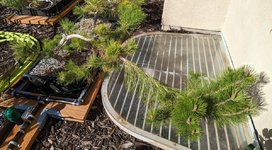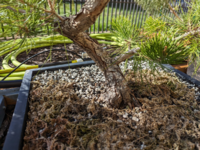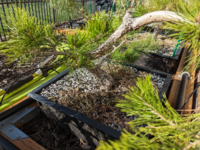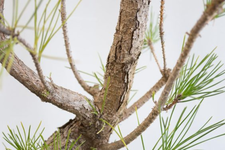jevanlewis
Mame
Overview
I have a JRP in development with a 4’ sacrifice branch. Since I want to thicken the trunk more, I plan to keep a sacrifice branch, either the current one or others I transition to, for several more years.
Tree goals:
Ideally, I can leave the existing sacrifice branch for longer: due to its significant foliage mass, removing/reducing now will slow down trunk widening. I have heard a rule of thumb that I should leave the existing sacrifice branch until the next sacrifice branch is 2/3 the size of the trunk. Unfortunately, my next sacrifice branch is only 1/10 to 1/5 the size of the trunk.
On the other hand, the problem with the current sacrifice branch is that where I will eventually cut it is facing forward, and therefore will leave a visible scar when viewing the tree from the front. I know that with time and proper technique, I probably can get the scar to heal over. Additionally, I am worried about bulge/inverse taper where the sacrifice branch starts if I don’t reduce/remove it this year (I would probably do an initial cutback this fall/winter, and then remove the remaining the following fall/winter).
Questions
Here are my questions for the group (other advice not related to these questions is, of course, welcome):


Additional Tree Images
Image 1: Zoom out with view of sacrifice (the front of the tree is the direction of the sacrifice branch)

Image 2: Zoom in on the trunk from front of tree

Image 3: View from front-left

Image 4: View from front-right

Image 5: View from back

I have a JRP in development with a 4’ sacrifice branch. Since I want to thicken the trunk more, I plan to keep a sacrifice branch, either the current one or others I transition to, for several more years.
Tree goals:
- Trunk diameter: 3-4” (currently 2.5” at lowest point)
- Height: 24-36”
- Style: Informal upright
Ideally, I can leave the existing sacrifice branch for longer: due to its significant foliage mass, removing/reducing now will slow down trunk widening. I have heard a rule of thumb that I should leave the existing sacrifice branch until the next sacrifice branch is 2/3 the size of the trunk. Unfortunately, my next sacrifice branch is only 1/10 to 1/5 the size of the trunk.
On the other hand, the problem with the current sacrifice branch is that where I will eventually cut it is facing forward, and therefore will leave a visible scar when viewing the tree from the front. I know that with time and proper technique, I probably can get the scar to heal over. Additionally, I am worried about bulge/inverse taper where the sacrifice branch starts if I don’t reduce/remove it this year (I would probably do an initial cutback this fall/winter, and then remove the remaining the following fall/winter).
Questions
Here are my questions for the group (other advice not related to these questions is, of course, welcome):
- Should I transition away from this sacrifice branch this year?
- When I transition to a new sacrifice, how many stages of reduction do you recommend?
- When I transition to a new sacrifice, any advice on how/where to cut to minimize scarring and mitigate chances of bulge/inverse taper?
- Regardless of when I transition to a new sacrifice, I do plan to pull several needles and cut back some branches on the sacrifice branch this year, primarily to promote more growth lower down. Can I do this reduction now, or should I wait until fall?
- Future trunk (blue)
- New sacrifice (red)
- Existing side branches (green)
- Extra branch (yellow): could be used as new leader, new sacrifice, or even side branch to replace existing side branches


Additional Tree Images
Image 1: Zoom out with view of sacrifice (the front of the tree is the direction of the sacrifice branch)

Image 2: Zoom in on the trunk from front of tree

Image 3: View from front-left

Image 4: View from front-right

Image 5: View from back












